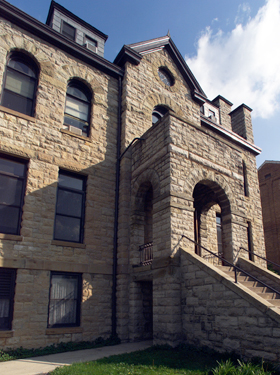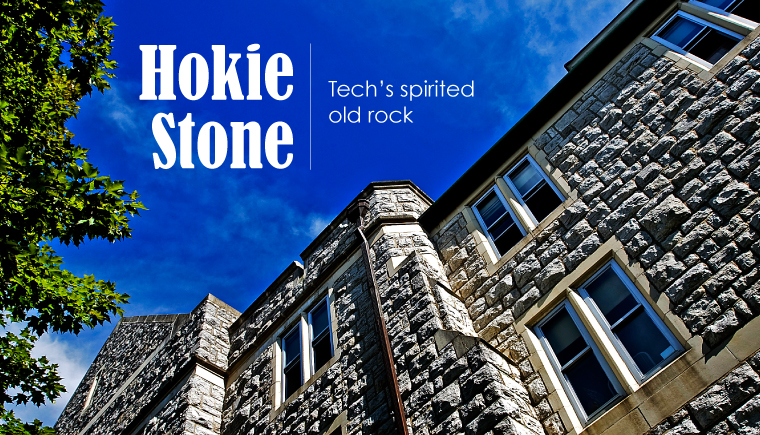|
by CLARA B. COX M.A. '84
CAN A ROCK HAVE SPIRIT?
Some would argue that Hokie Stone contributes to--perhaps even serves as a foundation of--Hokie Spirit.
The native limestone, mined at the university's own quarry, has defined the campus scene for more than a hundred years. The rocks have become so integral to the aura of Virginia Tech that the board of visitors decreed in the mid-1990s that all buildings constructed in the central campus thenceforth must be clad in Hokie Stone.
HISTORY OF ITS USE
|
|
|
|
|
|
|
|
|
|
|
|
|
|
|
|
|
 |
|
|
|
|
|
Rick Griffiths
|
|
|
|
|
|
|
|
|
|
|
|
YMCA Building (now Performing Arts
Building), whose cornerstone was laid
in June 1899 |
|
|
|
|
|
|
|
|
|
|
|
|
|
|
|
|
|
|
|
|
|
|
|
|
Campus use of these limestone slabs dates back to the late 1800s, when alumni donated money to construct a building on campus for the YMCA, which advised and counseled students and provided them with social activities. The cornerstone was laid on June 20, 1899.
Richmond architect W. F. West designed the facility, known today as the Performing Arts Building. West produced a Romanesque-inspired design clad in rough limestone, which proved to be popular with President John McBryde (1891-1907) and his faculty, who called the material "our native limestone."
In 1905, the first building was erected that reflected the university's prevailing neo-Gothic architectural style. Plans for the Chapel, which later became the college library, called for a brick exterior, but difficulty in securing the bricks led builders to use easily accessible limestone instead. By then, Tech had located limestone deposits on campus--in the area where Derring and Cowgill Halls now stand--where it quarried dark gray stone, called "black limestone." Another native-limestone-clad building, Price Hall, was completed in 1907.
Still, most buildings were brick and reflected Victorian styles. McBryde's successor, Joseph D. Eggleston (1913-19), compared them to "poverty stricken textile mills" and convinced the board of visitors to hire the architectural firm Carneal and Johnston to develop a plan for campus structures based on the Gothic style of architecture prevalent at European universities.
The first resulting building, the McBryde Building of Mechanic Arts, completed in 1917 and razed in 1966, was constructed of native limestone and became the prototype for numerous buildings that followed, including Burruss Hall.
FORMATION AND TRANSFORMATION
Some 300 million years old, Hokie Stone is unique to the Appalachian region of Virginia, Tennessee, and Alabama. Technically a Chepultepec and Kingsport Formation dolomite, which is rich in calcium and magnesium, this sedimentary rock began to emerge at the end of the Paleozoic Age, when the continental drift forced the coastal plains of Africa and North America to collide, creating wrinkled layers of faults and folds. As natural forces pushed these layers near the earth's surface, they formed the stone so popular in the Hokie Nation.
The rock's varied colors--yellows, grays, browns, blacks, and maroons, among others--resulted from different conditions present when the stone was formed. Pinkish tones found in older dolomites resulted from arid, desert-like climates, while darker gray and black stones reflect their creation in swampy and wetter conditions.
Several sites for the limestone exist in the Blacksburg region. In 1975, the Virginia Tech Foundation purchased a 38-acre quarry that had been in operation since 1958 and added 10 more acres in 2007. Located within the Blacksburg town limits, the quarry provides 80 percent of the Hokie Stones used on new campus buildings. To get variations in color, the university purchases the remaining 20 percent from a farm in Montgomery County.
Workers at the quarry use a relatively quiet explosive to fracture the shelf-like formation. They employ other processes to eventually break the stones into the approximately 2 feet by 1 foot size most commonly used for cutting and for carving the outer face to the desired level of surface relief. Each stonemason uses hammers and chisels to accomplish the last steps by hand, shaping, smoothing, and dressing about a ton of stones per day.
Recently, the university purchased equipment to slice the stone into brick-like depths, reducing the bulk--and the cost--of cladding a building. This technique will be used for the first time on the new Visitor and Undergraduate Admissions Center, scheduled to open in June 2011 (see "Donations fuel high-profile projects" in the winter 2009-10 issue).
The quarry produces approximately 55 tons of Hokie Stone per week, about 2,600 tons per year. Each ton will cover approximately 35 square feet on a building. Typical campus buildings use about 1,500 tons of stone, or more than 82,000 individual stones.
AN EMBLEM OF SPIRIT
For the university's football team, Hokie Stone has become a lucky talisman and a symbol of achievement. The last thing each football player does before entering Worsham Field is stroke a Hokie Stone embedded over the Lane Stadium doorway. Beside the stone are the words: "For those who have passed, for those to come, reach for excellence."
The limestone's prevalence in the mindset of the Hokie Nation was reiterated in 2007 when Hokies United placed a block of Hokie Stone in a memorial for each student and faculty member killed on April 16.
That memorial inspired the permanent memorial, which includes 32 Hokie Stones, each engraved with the name of one who died that day. "With our native limestone as the base, we have etched their names into the foundation of this great university," said the late Zenobia Hikes, vice president of Student Affairs, at the dedication ceremony.
In late afternoon or early morning on bright, cloudless days, sunlight striking campus buildings appears to give the Hokie Stones an inner glow. The soft, muted colors stand in stark contrast to the mental image of a hard, grey stone building, visually bringing the buildings to life. That visual image remains in the memory, long after one leaves campus, and the stones often become synonymous with thoughts of Virginia Tech.
Hokie Stone, the heart of campus construction, has become the manifestation of Virginia Tech's resilience and spirit.
|



